How to Start an Alpaca Farm: A Quick Guide
Alpacas are a synonym for agriculture that’s sustainable as it can be.
Such farming enterprises are still kind of alternative, but they are a great way to shift the focus from conventional agricultural systems that damage the ecosystem. Alpacas are one of the best options when you want to combine sustainable farming practices with perfect family livestock.
Starting a farm with these peaceful and intelligent furry creatures can also be a perfect way to earn profits. These low-maintenance animals can be raised not only for their fleece but also for leather and meat. If you want to start hobby farming on a rural property, investing in alpacas is a great idea.
By this point, you’ve guessed it – this article will discuss how to start an alpaca farm business.
Why Is Alpaca Farming Getting Popular in Australia?

Here’s some news for you — the number of Alpacas in Australia has touched 400,000!
Considering that the first animals arrived in Australia a mere 25 years ago from South America, the growth rate is fantastic. With the global demand for alpaca fibre expected to be around USD 5.32 Billion by 2032, the industry is all set for brighter days in the coming years.
But what’s the reason behind this enormous growth?
The main reason is the rise in awareness among consumers resulting in a higher demand for natural and environmentally friendly fibres. This demand for natural clothing and fashion accessories has gone up significantly and “100% alpaca” products are fetching high prices.
And if you’ve ever worn anything made from their wool, you’ll know what I’m talking about. The luxurious and soft feel of it makes it a worthy substitute for products like cashmere and sheep’s wool. Besides, the superior tensile strength of the fibre makes it more wear-resistant than wool.
And unlike sheep’s wool, alpaca fibre is odour-free. This means there’s no need to come up with stories to persuade your kids to wear it.
Also, modern consumers have less reason to be concerned about the ethical treatment of these animals. Since alpaca farming is mostly fuss-free and the animals are well-treated, there are fewer concerns about animal welfare.
The Australian Alpaca Association (AAA) is the centralised collector of fleece on behalf of Australian Alpaca Fleece Ltd. The fleece is shipped off to Peru where it is graded and processed. Obviously, the finest fleece attracts the best price.

While alpaca is a fibre-first industry, the meat is also becoming a popular choice. The meat is leaner and contains fewer calories and fat than other red meat options. Many gourmets consider Alpaca meat as tasty as deer meat. Some farms in New Zealand are already supplying alpaca meat to supermarkets as an exotic product.
Hear it from Jenny Menzies, an Alpaca farm owner in New South Wales: “Previously everybody wondered ‘Well, what are we going to do with this fleece?’ Now we can actually sell everything that comes off the animal.”
In fact, farms are making sure that nothing goes to waste with alpacas. While the hides are converted into leather, the offal is used as pet food. Even if the wool price comes down, the farms can compensate by selling leather and meat. Moreover, Australian alpacas have superior genetics which has created a high demand for the stud stock in the international market.
However, the Australian alpaca industry needs to overcome a few challenges as well.
First of all, there is a lack of information about the production data and commercialization opportunities for alpaca farming. The general concept of associating alpacas with pets restricts the growth scope of the fibre and meat markets. Also, there are inconsistencies in the quality of the fibre and the supply chain infrastructure needs development.
How to Start an Alpaca Farm?
To begin with, you need to analyse the feasibility of alpaca farming.
That means determining the cost of raising the animals and comparing that with the revenue they will generate in future. You will need to register as an owner of livestock in Western Australia and will receive a Property Identification Code (PIC) card.
An alpaca breeder needs to have a small ranch with a shelter or a barn. In general, a space of around 3 square metres per animal should be just enough. The area should be properly fenced and have a steady supply of fresh, clean water.
In addition, there are the expenses of engaging labour. But there’s a shortcut around that one.
Newbie breeders can purchase the land and animals and place them under the care of an experienced breeder. This arrangement is known as “agistment,” and the breeder is responsible for managing the daily tasks related to the livestock.

In general, an acre of land should be enough for 5-15 alpacas. if you are feeding hay. In case you are expecting them to live off of pastures, then a larger land area will be needed. Likewise, if the land has more dirt and weeds than grass, the animal density needs to be lower.
Depending on factors like age, breed, and fibre quality, the price of each alpaca can vary. If you already have the land, consider the costs of setting up a barn and the fencing. In addition, there are food costs, healthcare costs, and grooming costs for the animals. You will also need standard shearing gear and weighing scales for weighing the fleece.
Note that hot and humid climates are not suitable for alpacas. They are susceptible to fungal diseases and stomach worm problems which are more common in such areas. Alpacas prefer a mostly dry climate, especially during the summer. The temperate and cooler regions of Australia are the best zones for alpaca farms.
Naturally fertile soil is good for alpaca breeding. However, the fibre quality is best when the soil is slightly poorer. Although their protein requirement is lesser than other ruminants, alpacas still need minerals like calcium, magnesium, copper and molybdenum.
And what if you have or plan on having other animals on the farm? How will they function together?
The good news is, alpacas bond well with other animals. Alpaca pairs can even act as fox guards while running with sheep and goats. But bringing them up with other ruminants can make them more vulnerable to internal parasites.
Not unlike miniature cows, they are also tame and amiable creatures your kids will enjoy spending time with.
All alpacas should be shorn once every year. Depending on the quality of the fleece, a single animal can generate between 0.5 and 4 kg of fibre.
Before you start an alpaca farm, it is best to seek as much information as you can. Find a knowledgeable mentor who can provide valuable advice. Online communities, research websites, and YouTube videos can also be good sources of information. Also, locate a local camelid vet who can help you with any issues with the animals.
How to Raise Alpacas?

Since alpacas are hardy creatures, raising them is not a challenging task. They are gentle creatures that are easy to handle. They can be trained and most importantly, they do not spit at humans like llamas. Unless you make an alpaca truly angry, it is not likely to spit at you.
But be warned: the spit smells.
So, be careful when you are vaccinating one or trimming the nails. Even so, you can train alpacas to tolerate basic examination procedures and nail trims. Alpacas have a herd mentality and do not prefer isolation. Left isolated, the animal can fall sick, and even die.
A basic shelter that offers protection from bad weather is the main requirement. Make sure to ensure adequate natural lighting in the shed as alpacas aren’t fond of dark environments. The shelter will also be necessary for recently shorn alpacas. It’s also easy to keep alpacas clean. Intelligent as they are, the animals poop in one or two communal spots.
Alpacas consume less food and one acre of pasture for every three to five animals should be sufficient. Some estimates suggest that an alpaca’s daily food consumption is 2% of its body weight. In winter, you may supplement the food with hay as a free choice.
Alpacas drink often and adult animals can consume around 5 litres per day. Note that they are somewhat picky about the water temperature. They tend to avoid water that’s too hot or too cold.
In terms of health, alpacas have a strong constitution. Diseases like flystrike and foot rot, common in sheep, hardly affect alpacas. Plus, pregnancy and births are mostly free from complications and most females give birth without any human support. That said, you need to monitor their health, especially for breeding animals.
The alpaca reproduction cycle is not favourable for artificial insemination. That makes natural alpaca pregnancies the best option. Since the animals remain pregnant for almost an entire year, the breeding opportunities are limited.
Lastly, alpacas have two sharp and curved canine teeth that can be 2-3 centimetres long. While they don’t bite humans, male alpacas can use their teeth to fight against other males. To avoid injuries, these teeth should be removed, or trimmed regularly.
What Makes Alpacas Environment Friendly?

Unlike sheep and goats, alpacas do not have hooves but padded feet. This leads to less pressure on the soil and reduces the erosion of the fertile topsoil. Data indicates the ground foot pressure applied by alpacas is less than that of the kangaroo. So, the smaller plants and fields of grass remain undamaged.
Since soil degradation is a major problem in the fragile landscape of Australia, alpacas are good choices to preserve soil quality. Moreover, alpacas move their dung pile around the farmland which helps to nourish the soil evenly. Alpaca manure is a great fertiliser. It breaks down quickly and requires no ageing.
Alpacas nibble the tips of the plants and do not pull out the roots. That means the grass can keep growing and there is no need for replanting. Since alpacas consume less water than sheep, they are the best choice for areas where water is scarce.
Lastly, Alpaca wool does not need any harsh chemicals for processing or dyeing. Since alpaca fibre has low grease content, simple washing is enough to clean the grease. The chemical-free production process makes it a more sustainable choice.
According to John Bradbury, a Fremantle-based wool processor , “Dyeing is expensive, time-consuming and there is obviously pollution from the chemicals, so [not dyeing] is a much better outcome environmentally and for the manufacturer.”
Final Thoughts
Counted among one of the oldest domesticated animals in the world, alpacas are a great option when you are planning to start a hobby farm. With the growing list of alpaca end products and blends it is also a perfect choice as a side business.
Overall, alpaca farming is an exciting adventure that can be a profitable venture with the right business plan.
Frequently Asked Questions
Can you make money from alpacas in Australia?
With a sound business plan, alpaca farms make money in Australia. The high demand for alpaca fibre and the fact that the average produce from each animal per year can be around 4-5 kg, make it possible to earn considerable profits.
What is the lifespan of an alpaca in Australia?
The expected lifespan of an alpaca is between 15-20 years.
How much is alpaca wool worth in Australia?
The price of fine-spinning alpaca tops is around AUD 35/kg. Baby alpaca wool is more expensive due to its finer qualities and is at around AUD 190/kg.

